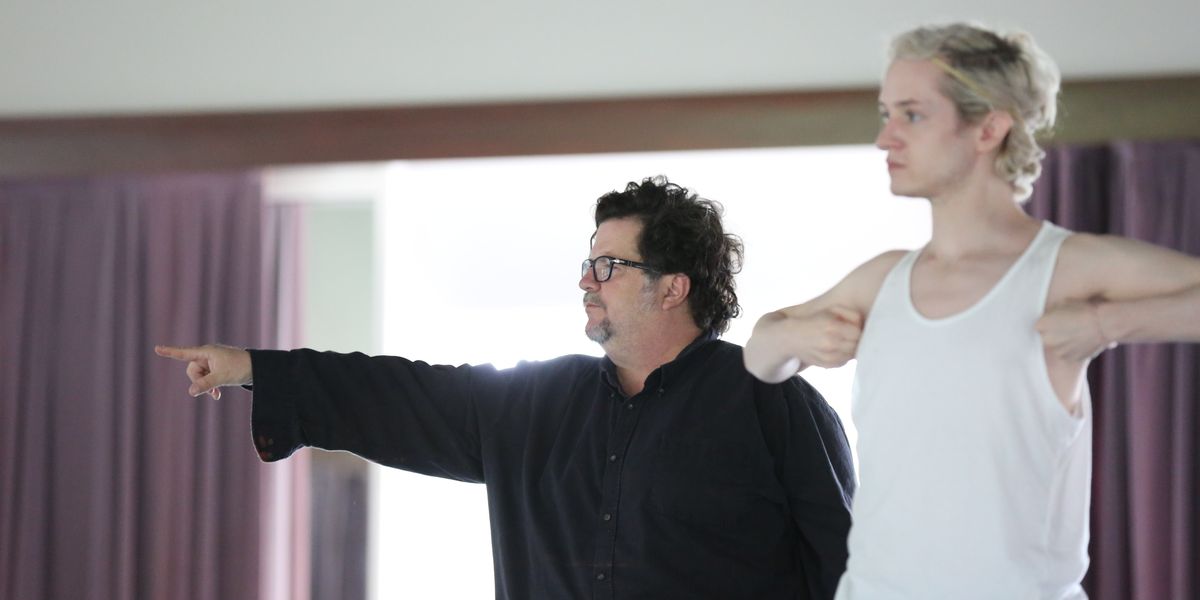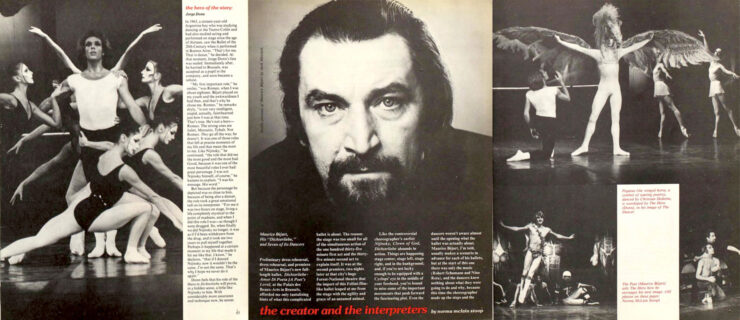Gay Men & Dance
When he was 7 years old, future choreographer Tere O’Connor donned a white V-neck tennis sweater, a pair of very short shorts, and his father’s trout fishing boots and sashayed down the street of his blue-collar neighborhood in Webster, New York. That inspired act of creativity was probably his first choreographed performance. “It was like a white suburban Grace Jones look,” says O’Connor. “I took it very seriously. I thought I was a real charmer.”
The stereotype of male dancers automatically being gay—not to mention the myth that dancing makes you queer—is a concept that Americans, in particular, love to embrace, as if to protect their own macho image. And yet, gay men do seem to be drawn to dance (and to other creative and equally stereotyped occupations like interior design, hairdressing, couture, and musical theater) for various reasons. In the universe of the arts, gay men keep some impressive company: Marcel Proust, Michelangelo, Lord Byron, Tchaikovsky, Tennessee Williams, Montgomery Clift, and Leonard Bernstein are only a few of history’s homosexuals who have made their indelible mark. (And, by the way, if you fear being around gay men, you probably should stop reading this article right now and quit dancing immediately, because you’re destined to meet a few along the way.)
A 1997 study published by J. Michael Bailey and Michael Oberschneider in Archives of Sexual Behavior, titled “Sexual Orientation and Professional Dance,” detailed a survey of 136 professional dancers, including homosexual and heterosexual men and women, about the prevalence of gay men in their profession. Their anecdotal responses indicated that they thought that 57.8 percent of the men in dance companies were gay, while they considered 53 percent of the men in their own companies to be gay. Even if those numbers are off by 10 points, those are still high ratios.
Gay men enter the dance field at ages ranging from 5 years old to their college years, but there are often common denominators in their motivations. Choreographer James Cunningham, who co-curates “From the Horse’s Mouth” (a performed compilation of notable dancers’ stories), worked with a dance and theater troupe from the age of 7. “I was not interested in cars, sports, or dating girls. I was interested in theater, dance, and music, where I could explore my emotional, sensual, sensitive side,” says Cunningham. “I played everything—men, women, animals, spirits. What I was learning was that when you’re a free spirit you can be everything.” Cunningham talks about the yin-yang balance that gay men possess (in sexual terms, that equates to both active and passive libido). “When they call gay people ‘fruits’ or ‘pansies,’ that means they have a soft side. Well, I embrace that,” he says. “To be a dancer, you have to give in to the rhythm.”
O’Connor has coined a term, “feminilia,” that describes the feminine creative spirit present in gay (and metrosexual) men and in women. “If gay men need to imprint the womanly element of being on earth, then it makes sense they would follow through with that at the career level,” says O’Connor. It was “feminilia” that allowed him to use his neighborhood street as a catwalk and to develop his own physical, non-verbal language. “It was dangerous to say you were gay,” he says. “I was developing some other language that was internalized and started to express itself through dance.”
For some, the idea of a physicality that was more aesthetic than competitive—more artsy than sporty—held broad appeal. The performance artist Tim Miller confesses that, “Dance class got me out of high school phys ed. It was a lifesaver that gave me an integrated, positive relationship with my body.” Christopher Williams, who choreographed Portuguese Suite to highlight the taboos of a homosexual union in a conservative backwater, considers his work queer in nature. “Our sense of beauty is undeniably influenced by our sexuality,” says Williams. “It follows logically that dance, which often offers views of male dancers publicly articulating their powerful and nubile bodies, as a form that reveres grace, subtlety and exciting feats of physical ability, plain and simply attracts the attention of gay men.” Or as Patrick Corbin, former lead dancer with the Paul Taylor Dance Company and now director of CorbinDances, puts it, “We have an appreciation for big, sweaty men in tights.”
Seeing attractive role models added to the allure of dance. Paul Thrussel, a former principal dancer with Boston Ballet who trained at the Royal Ballet School and now dances with Ballet Gamonet Maximum Dance in Florida, idolized Rudolph Nureyev. “Nureyev had such masculinity but at the same time was so camp and over the top. I always wanted to dance like that,” says Thrussel. Miller remembers the sexy iconic photographs in Dance Magazine and its provocative sister publication, After Dark, which shared photographers in the 1970s. “Some of the most beautifully charged images of this idealized dance beauty made a strong imprint. For me, coming of age, it was aestheticized in a queer cultural representation. But, then again, so did the Sears catalogue,” says Miller, whose book 1001 Beds describes his early sexual encounters at Cal State Fullerton’s dance department. And O’Connor idolized Aaron Osborne of the Limón Dance Company, not only because he was “like sex on toast,” but because he was a strong, confident, successful man in the dance world.
Lest anyone think that men in tights are always gay, let’s not forget that ballet’s biggest box office attraction was Mikhail Baryshnikov, a ladies’ man who made a number of straight men think ballet class might be a good way to meet chicks. Outside of the United States, countries like Russia and Cuba revere their male dancers and don’t label them as sissified. Even in this country, O’Connor says that he teaches more straight male dancers in college classes than before, as gender issues for the younger generation become less of a big deal.
But overwhelmingly, among the gay men interviewed for this article, the welcoming atmosphere of dance classes or companies made them want to stay once they got their foot in the door. Gay men are usually invited into the dance world without question, easily gain friends and peers, and are seldom judged for their sexual preference, as they might be elsewhere. The word “tribe” often pops up in the discussion of the bonding that happens among gay men. “Maybe boys changing into their dance belts and tights are the closest thing we could be to a tribe,” says Miller. Corbin recalls that at the Joffrey and Taylor companies, particularly at the height of the AIDS crisis, “There was never a better bunch of guys to have your back.” And Williams thinks that, just as cultures have engaged in survival rituals for centuries, so do gay men in dance: “We are hungry for a kind of codified cultural unity, for good mates, for personal lore or mythology and for a sense of belonging which has been denied us.”
While most religions have a poor track record in supporting gays and lesbians, a number of gay men who dance feel that their gayness and artistry are part of their spiritual path. “I think you are born this way and it’s karmic,” says Cunningham. “If we could ever find that gay gene, it would relieve the idea that this is something you have done to annoy your aunt.” O’Connor refers to his “creative motor” that resulted from marginalization and mobilized his artistic talent. Ronald K. Brown, whose choreography seems to spring from a heart-centered spirituality, says that his spiritual search led him to honor the freedom of being true to himself. “In that way,” says Brown, “my spirituality is fed by my being gay.”
So what do you say to parents who are afraid to let their son take dance classes because “it might turn him gay?” (One of Brown’s extended family members actually asked him, “Did that dancin’ thing make you gay?”) O’Connor thinks they should worry more about his finances than his being gay. “Dance isn’t the issue,” he says. “If you feel your son is gay, you should respond directly to that. If this is the first indicator, then you might have been a little sleepy.” Miller also says fear not: “If a gay boy can’t be turned straight by an absolute Niagara Falls of heterosexual programming, coercion and physical abuse, then a dance class is not going to make a straight boy gay.”
Cunningham, who has done extensive touring across the country, has encountered his fair share of people who regard dance as a sexually subversive, radically gay art form. In Alaska, after a performance of his piece The First Lady, in which Isadora Duncan, costumed in a pink tunic, and Donald Duck (both played by men) got married, a stern woman pulled him aside. “I just want to tell you that you have turned this high school auditorium into the house of Satan,” she said. In retrospect, says Cunningham, “That was the most profound compliment I ever got.”




